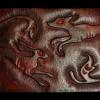
Antiquing & Resist Issues
By
Destrier, in Dyes, Antiques, Stains, Glues, Waxes, Finishes and Conditioners.

By
Destrier, in Dyes, Antiques, Stains, Glues, Waxes, Finishes and Conditioners.